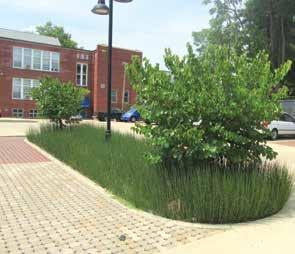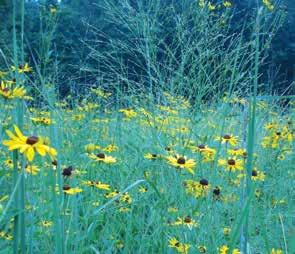
3 minute read
Somewhere, a Place for Over-performing Plants
You know the song from West Side Story, “Somewhere (There’s a Place for Us)”? That tune invaded my thoughts recently (and wouldn’t go away) as I was having a conversation with a homeowner. I asked, how do you feel about river oats and wild strawberry? Is there a place somewhere in the garden for them? I asked because these are den for almost all plants, even for plants that never played well in the sandbox with others, like ostrich fern.

Last week a colleague was fretting over ostrich fern (Matteuccia struthiopterus), because it was spreading beyond its confines in a moist woodland where it was planted. It has a sneaky way of spreading its tentacles (long underground mallow. They are all equally aggressive, sun-loving plants that fill space quickly and persist longterm.
(Equisetum hyemale). Ted Spaid, at SWT Design in St. Louis, incorporated this ancient, rampant, evergreen fern ally with redbuds, in the parking lot islands, at The College School in Webster Groves. Good choice mate, because this plant survived the dinosaurs, and the asteroid that killed them. That’s probably why they’re surviving so well in the baking-hot parking lot.

Finally, there is wild strawberry (Fragaria virginiana), which sometimes is referred to as a green or living mulch plant. Mervin Wallace, owner of Missouri Wildflowers Nursery, has been promoting this one as a filler plant between useful native plants, especially in naturalistic woodland and prairie gardens. But people shy away from them because they move around, and they can spread.

It’s plants like these that keep some horticulturists up at night and gives others a reason to label native plants as weeds. Sure, some native plants grow more quickly and overtake other plants, but aggressive plants exist across the entire northern hemisphere. But not all native plants move around; most of them don’t. That’s why I’m confused by native plant nay-sayers. Remember the saying—“right plant-right place.” There is a place in the gar- roots called rhizomes) far and wide until it finds a gap in which to pop up. In my colleague’s situation, it is happily colonizing the woods along a creek. There are other plants that spread and combine well with ostrich fern. For example, palm, hop, bur, and ravens-foot sedges are beautiful mixed with ostrich fern in woodlands. So are American beakgrain, river oats, Virginia knotweed, wild geranium, Jacob’s ladder, Virginia bluebells, celandine poppy, and golden groundsel. I like to mix them to create a naturalistic planting, vibrant with color and texture variation.
Another one of my favorite aggressive plants is horsetail,
SCOTT WOODBURY Horticulturist
What’s more, they are confined to a limited space, like a robot vacuum cleaner, filling in the bed so densely that weeds can’t get a foothold. Considering it’s a school full of children, and children love dinosaurs, and most (or all) schools aren’t staffed up for pulling weeds, it’s a stroke of genius.
There is a place for plants that sucker and spread in sunny areas too. Common milkweed (Asclepias syriaca) gets a bad rap because it moves around by rhizomes and seed. But I come across all sorts of situations that need plants like this. I recently consulted on a difficultto-mow slope above a retaining wall. My recommendation included common milkweed, switchgrass, sweet coneflower, curlytop ironweed, New England aster, and, to drape over the wall, purple poppy perennials and grasses in gardens. That’s also how it grows in a wild prairie. I can attest to its success, but I recommend that you install it a couple of years after an initial planting of desired plants. It is aggressive and may out-compete newly planted purple coneflower, wild indigo, Culver’s root, prairie coreopsis, rose turtlehead, butterfly milkweed, and others. Try it instead of applying wood or leaf mulch every year.
This reminds me of a favorite bumper sticker, given to me by the legendary Arkansas plantsman Larry Lowman. It reads “Minds are like parachutes, they only function when open.” There are many native plants, plant combinations, and planting situations yet to be discovered, so don’t take my word for it— let’s get tinkering, ya’ll.
Scott Woodbury was the horticulturist at Shaw Nature Reserve for 30 years and stepped down from that position in June 2022. He continues to work on contract for Shaw Nature Reserve to carry out native landscaping education and has launched his own business called Cacalia: Native Garden Design and Wilding. Find suppliers of native plants, seeds, and services at the Grow Native! Resource Guide: www.moprairie.org.
1601 NE Tudor Rd, Lee’s Summit, MO (816) 525-4226

Annuals, Vegetable Plants, Herbs, Lawn Fertilizers and more.

Special on ferti-lome 5-Step Lawn Care Program Shrubs and Trees arriving daily!
Missouri Wildflowers Nursery
573-496-3492, fax: 573-496-3003 www.mowildflowers.net mowldflrs@socket.net 9814 Pleasant Hill Rd Jefferson City MO 65109
Missouri Prairie Foundation Native Plant Sale at Anita B. Gorman Conservation Discovery Center, 4750 Troost Ave, Kansas City MO 64110.
Saturday, April 15, 10 a.m. to 2 p.m.
Deep Roots Native Plant Sale at Metropolitan Community College, Longview 500 SW Longview Rd, Lee’s Summit 64081. April 22, 10 a.m. to 2 p.m. deeprootskc.org
Native Plant Sale by Burroughs Audubon at 6212 NW Barry Rd. KC MO 64154. Backyard Bird Center 816-746-1113. Saturday, April 22, 10 a.m. to 2 p.m.

Shawnee Indian Mission Foundation - Native Plant Sale at 3403 W. 53rd St, Fairway KS 66205. Saturday, April 29, 9 a.m. to 2 p.m. shawneeindianmission.org
Missouri Prairie Foundation Native Plant Sale at Anita B. Gorman Conservation Discovery Center, 4750 Troost Ave, Kansas City MO 64110.
Saturday, May 13, 10 a.m. to 2 p.m.







